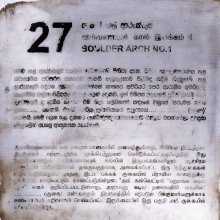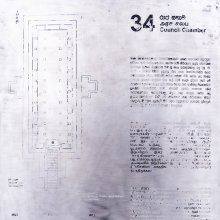Ena, Eṇa, Enā, Eṉa, Eṉā, Ēṉa: 18 definitions
Introduction:
Ena means something in Hinduism, Sanskrit, Buddhism, Pali, Jainism, Prakrit, Tamil. If you want to know the exact meaning, history, etymology or English translation of this term then check out the descriptions on this page. Add your comment or reference to a book if you want to contribute to this summary article.
Images (photo gallery)
(+2 more images available)
In Hinduism
Ayurveda (science of life)
Dietetics and Culinary Art (such as household cooking)
Source: Shodhganga: Dietetics and culinary art in ancient and medieval IndiaEṇa (एण) refers to a type of Jāṅghala meat and is mentioned as being beneficial (hita) to the body according to the 17th century Bhojanakutūhala (dravyaguṇāguṇa-kathana), and is commonly found in literature dealing with the topics of dietetics and culinary art, also known as Pākaśāstra or Pākakalā.—The dravyaguṇāguṇa section contains the discussions on different food articles and their dietetic effects according to the prominent Ayurvedic treatises. Here In the māṃsa (meats) group Eṇa is mentioned as beneficial to the body (hita).
Unclassified Ayurveda definitions
Source: Wisdom Library: Āyurveda and botanyEṇa (एण) is a Sanskrit word referring to a kind of deer (blackbuck, or “Indian antelope”). The meat of this animal is part of the māṃsavarga (‘group of flesh’), which is used throughout Ayurvedic literature. The animal Eṇa is part of the sub-group named Jāṅgalamṛga, refering to “animals living in forests”. It was classified by Caraka in his Carakasaṃhitā sūtrasthāna (chapter 27), a classical Ayurvedic work. Caraka defined such groups (vargas) based on the dietic properties of the substance.
The meat of the blackbuk (eṇa) is madhura in Rasa and madhura in Vipāka. It alleviates three doṣas, is wholesome, light and constipating. It is also anti-diuretic and cold.
Source: archive.org: Sushruta samhita, Volume IEṇa (एण)—Sanskrit word for “black deer”. This animal is from the group called Jaṅghāla (large-kneed). Jaṅghāla itself is a sub-group of the group of animals known as Jāṅghala (living in high ground and in a jungle)
The venison of the Ena species is sweet and astringent in taste, and palatable, and proves curative in diseases due to the deranged condition of the Pittam, blood and Kapham. It is astringent in its effect, imparts strength to the system, improves a relish for food and is a febrifuge.

Āyurveda (आयुर्वेद, ayurveda) is a branch of Indian science dealing with medicine, herbalism, taxology, anatomy, surgery, alchemy and related topics. Traditional practice of Āyurveda in ancient India dates back to at least the first millenium BC. Literature is commonly written in Sanskrit using various poetic metres.
Dharmashastra (religious law)
Source: Prācyā: Animals and animal products as reflected in Smṛti textsEṇa (एण) (or Ruru, Raṅku, Gokarṇa) refers to the animal “Nilgai [Blue bull]” (Boselaphus tragocamelus).—The Smṛtis mention several domestic as well as wild animals that are enumerated in context of specifying expiation for killing them, the flesh being used as a dietary article to give satisfaction to the Manes (Pitṛs) in Śrāddha rites, the law of transmigration due to various sins committed as well as in the context of specifying gifts to be given on various occasions. These animals [viz., Eṇa] are chiefly mentioned in the Manusmṛti, Parāśarasmṛti [Chap.6], Gautamasmṛti [17.2 and 15.1], Śātātapasmṛti [II.45-54], Uśānasmṛti [IX.7-9; IX.12-13], Yājñavalkyasmṛti [I.170-171; I.175; I.258- 260], Viṣṇusmṛti [51.3;51.6;51.26;51.33;80.3-14], Uttarāṅgirasasmṛti [X.15-17], Prajāpatismṛti [Śrāddhatyājyavastuvarṇanam. 138-143], 9 Kāśyapasmṛti [Section on Prāyaścittavarṇanam], Vṛddha Hārītasmṛti [6.253-255] and Kātyāyanasmṛti [27.11].

Dharmashastra (धर्मशास्त्र, dharmaśāstra) contains the instructions (shastra) regarding religious conduct of livelihood (dharma), ceremonies, jurisprudence (study of law) and more. It is categorized as smriti, an important and authoritative selection of books dealing with the Hindu lifestyle.
Languages of India and abroad
Pali-English dictionary
Source: BuddhaSasana: Concise Pali-English Dictionaryena : takes this form in some cases.
Source: Sutta: The Pali Text Society's Pali-English DictionaryEna, (pron.) (fr. pron. base *ē̆, cp. e-ka; to this cp. in form & meaning Lat. ūnus, Gr. oi)nόs, Ohg. ein, Oir. ōin) only used in Acc. enaṃ (taṃ enaṃ) “him, this one, the same” Sn.583, 981, 1114; Dh.118, 313; J.III, 395; Nd2 304III, B. See also naṃ. (Page 161)

Pali is the language of the Tipiṭaka, which is the sacred canon of Theravāda Buddhism and contains much of the Buddha’s speech. Closeley related to Sanskrit, both languages are used interchangeably between religions.
Sanskrit dictionary
Source: DDSA: The practical Sanskrit-English dictionaryEṇa (एण).—
1) A kind of black antelope; कांश्चिदेणान्समाजघ्ने शक्त्या शक्तिमतां वरः (kāṃścideṇānsamājaghne śaktyā śaktimatāṃ varaḥ) Mahābhārata (Bombay) 1.69.22; तस्य स्तनप्रणयि- भिर्महुरेणशावैः (tasya stanapraṇayi- bhirmahureṇaśāvaiḥ) the several kinds of deer are given in this verse :-अनृचो माणवो ज्ञेय एणः कृष्णमृगः स्मृतः । रुरुर्गौर- मुखप्रोक्तः शम्बरः शोण उच्यते (anṛco māṇavo jñeya eṇaḥ kṛṣṇamṛgaḥ smṛtaḥ | rururgaura- mukhaproktaḥ śambaraḥ śoṇa ucyate) ||
2) (In Astr.) Capricorn.
Derivable forms: eṇaḥ (एणः).
See also (synonyms): ekaṇa.
--- OR ---
Enā (एना).—ind. Ved. Thus, then, at that time परो दिवा पर एना पृथिव्या (paro divā para enā pṛthivyā) Ṛgveda 1.125.8.
Source: Cologne Digital Sanskrit Dictionaries: Shabda-Sagara Sanskrit-English DictionaryEṇa (एण).—mf. (-ṇaḥ-ṇī) A kind of deer or antelope, described as being of a black colour, with beautiful eyes, and short legs. E. iṇ to go, ṇa aff.
Source: Cologne Digital Sanskrit Dictionaries: Benfey Sanskrit-English DictionaryEṇa (एण).—m., f. ṇī, A kind of antelope, [Mānavadharmaśāstra] 3, 269.
Source: Cologne Digital Sanskrit Dictionaries: Cappeller Sanskrit-English DictionaryEṇa (एण).—[masculine] eṇī [feminine] a kind of black antelope.
--- OR ---
Ena (एन).—1. [pronoun] stem of 3d [person or personal] (used subst.).
--- OR ---
Ena (एन).—2. [masculine] deer (only —°).
--- OR ---
Enā (एना).—([instrumental] of 1 a [adverb]) thus, in this way, here, there, then, —enā paraḥ beyond here; para enā beyond ([with] [instrumental]).
Source: Cologne Digital Sanskrit Dictionaries: Monier-Williams Sanskrit-English Dictionary1) Eṇa (एण):—mf(ī). a species of deer or antelope (described as being of a black colour with beautiful eyes and short legs), [Atharva-veda v, 14, 11; Vājasaneyi-saṃhitā xxiv, 36; Manu-smṛti iii, 269; Mahābhārata etc.]
2) m. (in [astronomy]) Capricorn.
3) Ena (एन):—[from edha] 1 a [pronominal] base (used for certain cases of the 3rd personal pronoun, thus in the [accusative] [singular] [dual number] [plural] [enam, enām, enad, etc.], inst. [singular] [enena, enayā] [genitive case] [locative case] [dual number] [enayos, [Vedic or Veda] enos]; the other cases are formed [from] the [pronominal] base a See under idam), he, she, it
4) [v.s. ...] this, that, (this pronoun is enclitic and cannot begin a sentence; it is generally used alone, so that enam puruṣam, ‘that man’, would be very unusual if not incorrect. Grammarians assert that the substitution of enam etc. for imam or etam etc. takes place when something is referred to which has already been mentioned in a previous part of the sentence; See [grammar] 223 and 836)
5) [v.s. ...] cf. [Greek] ἕν, οἷος; [Gothic] ains; Old [Prussian] ains; [Latin] oinos, unus.
6) 2. ena and enā, [Vedic or Veda] [instrumental case] of idam q.v.
7) Enā (एना):—[from ena] ind. here, there
8) [v.s. ...] in this manner, thus
9) [v.s. ...] then, at that time, [Ṛg-veda; Atharva-veda]
10) [v.s. ...] (enā paras ind. further on [Ṛg-veda x, 27, 21; 31, 8]; para enā ind. beyond here; there; beyond [with [instrumental case]] [Ṛg-veda x, 125, 8]; yatra-enā, whither thither.)
11) Ena (एन):—3. ena (cf. eṇa), a stag. See an-ena.
Source: Cologne Digital Sanskrit Dictionaries: Yates Sanskrit-English DictionaryEṇa (एण):—[(ṇaḥ-ṇī)] 1. m. 3. f. A kind of deer or antelope, black, with fine eyes and short legs.
Source: DDSA: Paia-sadda-mahannavo; a comprehensive Prakrit Hindi dictionary (S)Eṇa (एण) in the Sanskrit language is related to the Prakrit word: Eṇa.
[Sanskrit to German]
Sanskrit, also spelled संस्कृतम् (saṃskṛtam), is an ancient language of India commonly seen as the grandmother of the Indo-European language family (even English!). Closely allied with Prakrit and Pali, Sanskrit is more exhaustive in both grammar and terms and has the most extensive collection of literature in the world, greatly surpassing its sister-languages Greek and Latin.
Prakrit-English dictionary
Source: DDSA: Paia-sadda-mahannavo; a comprehensive Prakrit Hindi dictionaryEṇa (एण) in the Prakrit language is related to the Sanskrit word: Eṇa.
Prakrit is an ancient language closely associated with both Pali and Sanskrit. Jain literature is often composed in this language or sub-dialects, such as the Agamas and their commentaries which are written in Ardhamagadhi and Maharashtri Prakrit. The earliest extant texts can be dated to as early as the 4th century BCE although core portions might be older.
Kannada-English dictionary
Source: Alar: Kannada-English corpusĒṇa (ಏಣ):—[noun] (masc.) any of various kinds of deer; a black antelope.
--- OR ---
Ēna (ಏನ):—[noun] an offence against religious or moral law; an action that is or is felt to be highly reprehensible ಒರ [ora] transgression of the law of God; a sin.
Kannada is a Dravidian language (as opposed to the Indo-European language family) mainly spoken in the southwestern region of India.
Tamil dictionary
Source: DDSA: University of Madras: Tamil LexiconEṉa (என) < என்-. [en-.] particle
1. See என்று¹ [enru¹],
2. (தொல். சொல். [thol. sol.] 260.)
2. A sign of comparison; ஓருவமவுருபு. புலியெனப் பாய்ந்தான். [oruvamavurupu. puliyenap paynthan.]
--- OR ---
Eṉā (எனா) particle < என்-. [en-.] Connective of things enumerated, as in நிலனெனா நீரெனா; ஓரெண்ணிடைச் சொல். [nilanena nirena; orennidais sol.] (நன். [nan.] 428.)
--- OR ---
Ēṉa (ஏன) pronominal < ஏன்². [en².] (Impers.) Others, the rest; பிற. முதலா வேன [pira. muthala vena] (தொல். எழுத். [thol. ezhuth.] 66).
Tamil is an ancient language of India from the Dravidian family spoken by roughly 250 million people mainly in southern India and Sri Lanka.
See also (Relevant definitions)
Starts with (+63): E-nanam, E-nane, Enabhrit, Enabunul, Enad, Enadhara, Enadharadhara, Enadharamauli, Enadrish, Enaga, Enagamtu, Enagona, Enagonatana, Enah, Enaikkumonai, Enaime, Enaippala, Enaivan, Enaivar, Enaiyatum.
Ends with (+1101): Abdhiphena, Abhayaraja Parivena, Abhipurvena, Abhishena, Acacia megaladena, Accayena, Acchidrena, Achirachirachirena, Aciraciracirena, Acirena, Acucena, Adavi maamena, Adavihena, Adavimaamena, Adavimamena, Adena, Adhaena, Adharena, Adhistena, Adhokshena.
Full-text (+294): Enas, Enashiras, Enatilaka, Ainasa, Aineya, Enasvin, Enaka, Aina, Enabhrit, Enajina, Enam, Anenas, Enapanam, Enavayan, Vyenas, Nirbadhya, Ainika, Bahvenas, Enanka, Enadrish.
Relevant text
Search found 88 books and stories containing Ena, Aena, Eṇa, Enā, Ēṇa, Ēna, Eṉa, Eṉā, Ēṉa, Enaa; (plurals include: Enas, Aenas, Eṇas, Enās, Ēṇas, Ēnas, Eṉas, Eṉās, Ēṉas, Enaas). You can also click to the full overview containing English textual excerpts. Below are direct links for the most relevant articles:
Rig Veda (translation and commentary) (by H. H. Wilson)
Garga Samhita (English) (by Danavir Goswami)
Verse 6.10.25 < [Chapter 10 - In the Description of the Gomatī River, the Glories of Cakra-tīrtha]
Verse 5.5.33 < [Chapter 5 - Śrī Kṛṣṇa’s Entrance Into Mathurā]
Verse 2.2.2 < [Chapter 2 - Description of Girirāja Govardhana’s Birth]
Shrimad Bhagavad-gita (by Narayana Gosvami)
Verse 2.19 < [Chapter 2 - Sāṅkhya-yoga (Yoga through distinguishing the Soul from the Body)]
Verse 6.27 < [Chapter 6 - Dhyāna-yoga (Yoga through the Path of Meditation)]
Verse 2.29 < [Chapter 2 - Sāṅkhya-yoga (Yoga through distinguishing the Soul from the Body)]
Dvisahasri of Tembesvami (Summary and Study) (by Upadhyay Mihirkumar Sudhirbhai)
Incorporation of Grammar in the Dvisāhasrī < [H. H. Ṭembesvāmī: Erudition]
Appendix 4 - Some Important words employed in the Dvisāhasrī
Manusmriti with the Commentary of Medhatithi (by Ganganatha Jha)
Verse 3.269 < [Section XXI - Relative Merits of the Offering-Materials]
Verse 11.82 < [Section VII - Special Expiation for Special Offences: (a) For Killing a Brāhmaṇa]
Verse 2.102 < [Section XIX - Twilight Prayers]
Malatimadhava (study) (by Jintu Moni Dutta)
Part 1.3e - Adbhuta Rasa (The Marvelous Sentiment) < [Chapter 2 - Literary Study of the Mālatīmādhava]





